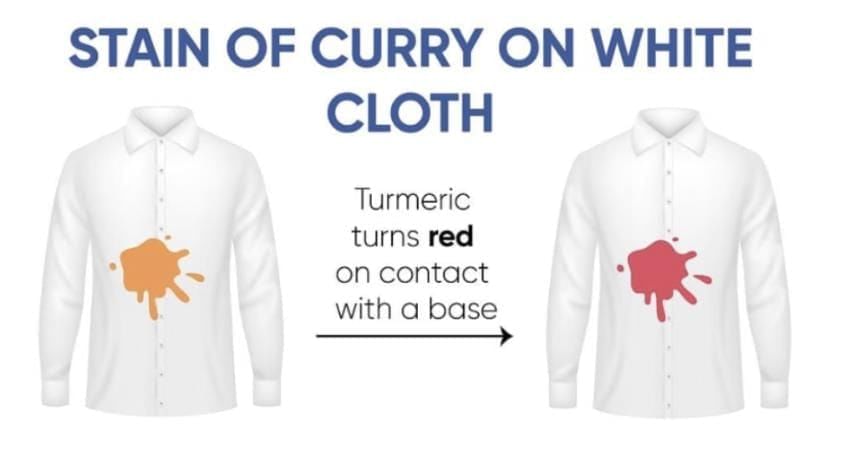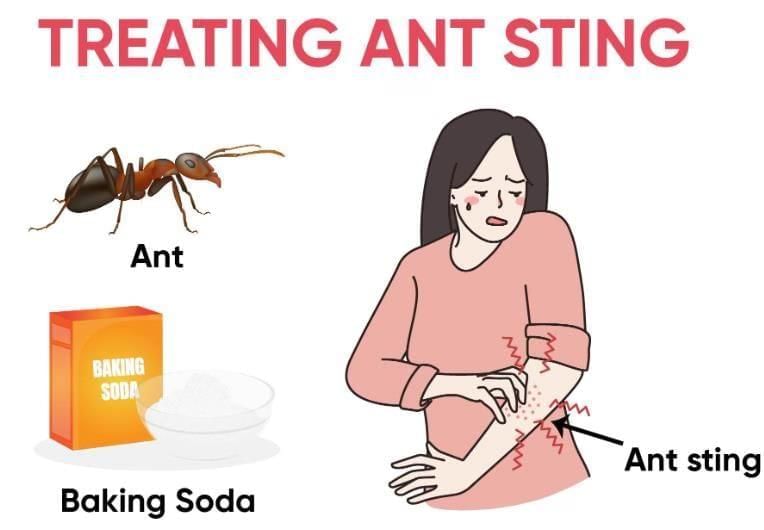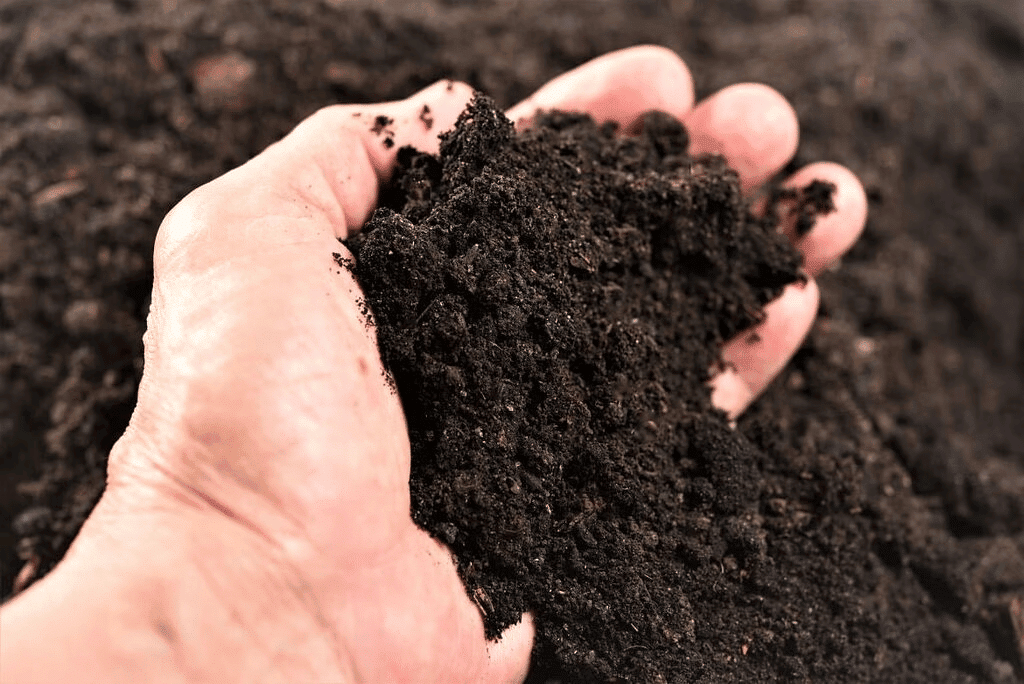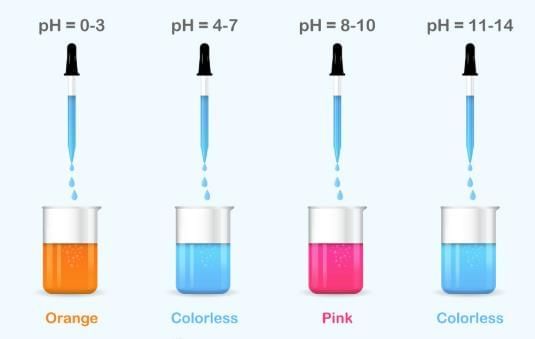Class 7 Science Chapter 2 HOTS Questions - Exploring Substances: Acidic, Basic and Neutral
Q1: Why does a turmeric stain on a white shirt turn red when it is washed with soap?
Ans: Turmeric contains a natural yellow pigment that changes colour depending on the pH of the solution.
- When turmeric stains a shirt, it remains yellow in neutral or acidic conditions.
- However, soap solutions are basic (alkaline) in nature.
- When the turmeric stain comes in contact with the basic soap solution, the curcumin reacts and changes its color to red.
- This is why the turmeric stain turns red while washing with soap.
 Q2: Which acid is injected into our body by an ant sting that causes pain?
Q2: Which acid is injected into our body by an ant sting that causes pain?
Ans:
- The acid injected into our body by an ant sting is formic acid.
- When an ant bites or stings, it releases formic acid into the skin, which causes a burning sensation and pain.
- Formic acid is responsible for the irritation and discomfort caused by ant stings.
Q3: Form a sentence using the following words: baking soda, ant bite, moist, effect, neutralised, rubbing.
Ans: The effect of an ant bite can be neutralised by rubbing moist baking soda.
Q4: While playing in a park, a child was stung by a bee. Some elders suggested applying a paste of baking soda and others lemon juice as a remedy. Which remedy do you think is appropriate and why?
Ans: A bee sting injects a liquid into the skin, which is acidic in nature. Hence, baking soda is the appropriate remedy as it is basic in nature and neutralises the acid.
Q5: Gurbir observed that most of the fish in the pond in her village were gradually dying. He also observed that the wastes of a factory in their village are flowing into the pond, which probably caused the fish to die.
(a) Explain why the fish were dying?
(b) If the factory waste is acidic in nature, how can it be neutralised?
Ans:
(a) If the wastes of a factory flow into waterbodies, it can cause a threat to the lives of sea creatures and to anybody who drinks the water. Since factory wastes may contain acids or bases and they can kill the fish.
(b) If the factory waste is acidic in nature, it can be neutralised by adding basic substances.
Q6: A farmer was unhappy because of his low crop yield. He discussed the problem with an agricultural scientist and realised that the soil of his field was either too acidic or too basic. What remedy would you suggest to the farmer to neutralise the soil?
Ans:
- The reason for low crop yield in farmers’ fields was that the soil at the place is either too acidic or too basic.
- The soil may be acidic or basic naturally.
- The excessive use of fertilisers in the fields also makes the soil too acidic.
- When the soil is too acidic, it is treated with a base such as quicklime (calcium oxide) or slaked lime (calcium hydroxide), which neutralises the excess acid present in the soil and reduces its acidic nature.
- If the soil is too basic, then decaying organic matter (called manure or compost) is added to it.
- The decaying organic matter releases acid, which neutralises the excess bases present in the soil and reduces its basic nature.
 Organic Matter
Organic Matter
Q7: Ashwin, Keerthi and their friend Gurdip were provided with a test, each containing Red rose solution, which was pink in colour. Ashwin added 2 drops of solution ‘A’ in his test tube and got dark pink colour. Keerthi added 2 drops of solution ‘S’ to her test tube and got a green colour. Gurdip added 2 drops of solution ‘C but could not get any change in colour. Suggest the possible cause for the variation in their results.
Ans: China rose (gudhal) is an acid-base indicator.
- China rose solution in different media shows the following changes:
- China rose → acid → Gives dark pink colour, hence A is an acidic solution.
- China rose → base → Gives a green colour, hence 6 is a basic solution.
- China rose neutral → No change in colour, hence C is a neutral solution.
Q8: Look at the given reaction.
Hydrochloric acid + Sodium hydroxide (base) → Sodium chloride (salt) + Water
Sodium chloride formed in this reaction remains in solution form. Can we get solid sodium chloride from this solution? Suggest a method (if any).
Ans: We can get solid sodium chloride by evaporation method. Evaporation is the process by which water changes from a liquid to a gas or vapour.
Rate of evaporation increases with temperature.
Q9: Phenolphthalein is a synthetic indicator and its colours in acidic and basic solutions respectively are
(a) red and blue
(b) blue and red
(c) pink and colourless
(d) colourless and pink
Ans: (d) colourless and pink
Phenolphthalein remains colourless in acidic solutions and turns pink in basic solutions.
 Phenolphthalein IndicatorQ10: When the soil is too basic, plants do not grow well in it. To improve its quality, what must be added to the soil?
Phenolphthalein IndicatorQ10: When the soil is too basic, plants do not grow well in it. To improve its quality, what must be added to the soil?
(a) Organic matter
(b) Quicklime
(c) Slaked lime
(d) Calamine solution
Ans: (a) Organic matter
Organic matter releases acids during decomposition, which help neutralise the excess base in the soil.
Q11: Neutralisation reaction is a
(a) physical and reversible change
(b) physical change that cannot be reversed
(c) chemical and reversible change
(d) chemical change that cannot be reversed
Ans: (d) chemical change that cannot be reversed
Neutralisation involves a chemical reaction between an acid and a base to form salt and water. It is a permanent chemical change.
Q12: Which of the following is an acid-base indicator?
(a) Vinegar
(b) Lime water
(c) Turmeric
(d) Baking soda
Ans: (c) Turmeric
Turmeric is a natural indicator that turns red in basic solutions and remains yellow in acidic or neutral solutions.
Turmeric
Q13: Fill in the Blanks
(i) Lemon juice and vinegar taste ______ because they contain________
Ans: sour, acids
Acids give a sour taste to substances.
(ii) When an acidic solution is mixed with a basic solution, they _______ each other, forming _______ and water.
Ans: neutralise, salt
This is a neutralisation reaction between an acid and a base.
Q14: True/False
(i) All substances are either acidic or basic.
(ii) Lime water turns red litmus blue.
Ans:
(i) False – Substances can also be neutral (like water).
(ii) True – Lime water is basic and turns red litmus blue, indicating a base.
Q15: Why is litmus a better natural indicator than other natural indicators?
Ans: Litmus gives a wide range of colour changes from weak acid to strong acid and from weak base to strong base. Other natural indicator, on the other hand, do not show a wide colour change.
Q16: In the reaction given below, how can we get solid sodium chloride from its solution?
Hydrochloric acid + Sodium hydroxide ➝ Sodium chloride + Water
Ans: Through the process of evaporation, we can get solid sodium chloride from its solution. We must evaporate the water in a container over a burner until all the water from the mixture evaporates.
Q17: A shopkeeper has a few bottles of soft drinks in his shop. But, unfortunately, these are not labelled. He has to serve the drinks on the demand of customers. One customer wants an acidic drink; another wants a basic and the third one wants a neutral drink. How will he decide which drink is to be served to whom?
Ans: Based on the properties of acids and bases, he can differentiate all the drinks.
- An acidic drink will have a sour taste and will turn blue litmus red.
- A basic drink will turn red litmus blue.
- A neutral drink will not change the colour of red or blue litmus.
- Apart from this, he can also use a turmeric solution to check the drinks.
Q18: Arnav is provided with three kinds of liquids, of which one is sodium hydroxide, another is hydrochloric acid, and the third is a sugar solution. How will he identify them when he has only the turmeric indicator?
Ans: Turmeric is yellow in colour. When it is exposed to neutral (Sugar Solution) or acidic substances (Hydrochloric Acid) it will retain its yellow colouration.
- However, if turmeric is exposed to more alkaline substances (sodium hydroxide) it becomes a dark pink/red.
- So first we detect sodium hydroxide - a basic substance by a colour change from yellow to dark or red.
- Then will test for an acid or neutral substance with an indication of no colour change.
- Now out of these two, we will mix one with the already tested solution for basic substance - sodium hydroxide with dark or red colour, if on mixing the colour reverses back to yellow, the liquid is an acid, and the remaining third liquid is neutral.
|
80 videos|224 docs|12 tests
|
FAQs on Class 7 Science Chapter 2 HOTS Questions - Exploring Substances: Acidic, Basic and Neutral
| 1. What are acids and bases, and how do they differ from each other? |  |
| 2. How can we identify whether a substance is acidic, basic, or neutral? |  |
| 3. What are some common examples of acidic and basic substances found in our daily lives? |  |
| 4. Why is it important to understand the pH of substances? |  |
| 5. What safety precautions should be taken when dealing with acids and bases? |  |

















